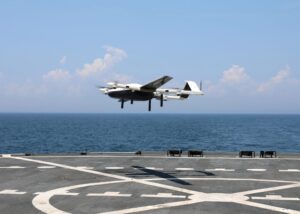
USN Cargo Drone
The Royal Fleet Auxiliary is looking at the use of small drones to deliver mail drops and other supplies to ships at sea. According to a news release: “The Royal Fleet Auxiliary (RFA) – whose ships and sailors have supported Royal Navy operations since 1905 with fuel, food, spare parts, ammunition and other supplies – is looking into the possibility of crewless aircraft performing some of the more routine, lighter duties. The classic image of the Royal Fleet Auxiliary is of a tanker sailing parallel with a warship and either pumping fuel into its tanks via a hose, or transferring supplies in crates and on pallets on a jackstay line slung between the two vessels. But helicopters are also used extensively to move loads around the fleet, typically in large nets carried beneath the aircraft.
During the recent Carrier Strike Group deployment supporting HMS Queen Elizabeth’s mission to the Pacific and back, supply ship RFA Fort Victoria shipped nearly 900 loads to the carrier and other ships in the task group, encompassing food and drink, general stores, spare parts, medical supplies, mail and parts for F-35 stealth fighters and Merlin and Wildcat helicopters – over 354 tonnes of supplies in all – while tanker RFA Tidespring carried out 67 ‘vertical replenishments’ as they are known. While some loads are too heavy for current small-scale drones to transport, seven out of ten resupply missions involve the transfer of loads up to 45kg, so the head of the RFA, Commodore David Eagles, wants to see if the work is ‘dronable’.”
The US Navy’s Naval Air Systems Command is experimenting with unmanned aircraft moving relatively lightweight supplies – up to 11kg – between ships, but over distances which could be greater than 200 miles. “Trials over the summer successfully proved this concept by delivering a small cargo for repairs between a warship and an auxiliary of the Military Sealift Command – the US Navy’s equivalent of the RFA. Royal Marines have tested re-supply by drone both on the battlefield and on the beachhead, using autonomous systems, from Malloy Aeronautics Ltd, to ferry up to 150lbs/68kg supplies; including ammunition, blood and Bergen backpacks to troops in the line from either ships off shore or bases to the rear.” “The RFA is looking very closely at the Military Sealift Command and the opportunities around using drones to make deliveries at sea,” said Commodore Eagles in the news release.
The Royal Navy is also looking at heavy lift drones to move payloads to ships and personnel. According to a news release, Royal Naval Air Station Culdrose hosted the inaugural Heavy Lift Challenge, calling on drone manufacturers to showcase crewless technology which could be adapted to carry supplies and cargo to ships and personnel. “The competition was a chance for the navy to test how it can quicken the procurement process and get off-the-shelf, readily-available tech into the hands of sailors and marines sooner. The Royal Navy and Royal Marines have already put a range of drones through their paces, demonstrating ability to lift and deliver payloads in excess of 100kgs.”
Source: UK Defence Journal

The unmanned vehicle component from the U.S. Navy’s Blue Water logistics Unmanned Aerial System, of the Naval Air Warfare Center Aircraft Division’s (NAWCAD) UX-24 Unmanned Test Squadron, takes off from the flight deck of Military Sealift Command’s fleet replenishment oiler USNS Joshua Humphreys while the ship was at sea in the Atlantic Ocean. This UAS flight proved the feasibility of using unmanned aircraft to transport small payloads of cargo from one ship to another while operating in a maritime environment. (U.S. Navy photo by Bill Mesta/released)
